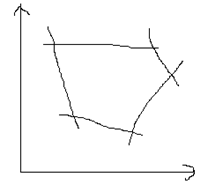This set of Fermentation Technology Multiple Choice Questions & Answers (MCQs) focuses on “Aeration and Agitation – Scale Up and Scale Down”.
1. What do you mean by ‘scale-up’?
a) Decreasing the scale of fermentation
b) Increasing the scale of fermentation
c) Decreasing the rate of agitation
d) Increasing the rate of fermentation
View Answer
Explanation: Scale-up means increasing the scale of fermentation. Increasing the scale of fermentation involves the increase in volume that is from small scale to large scale.
2. Which of the following is not a scale-up process?
a) Laboratory to pilot-scale
b) Pilot-scale to industrial-scale
c) Industrial to pilot-scale
d) Laboratory to industrial-scale
View Answer
Explanation: The scale-up process involves increasing the scale of fermentation by performing the experiments at laboratory or pilot scale and build large-scale fermenters with sufficient confidence that it will function properly.
3. Which of the following factors are not involved in the scale-up process?
a) Inoculum development
b) Sterilization
c) Temperature
d) Medium design
View Answer
Explanation: The factors involved in the scale-up process are inoculum development, sterilization, and environmental parameters like temperature, pH, foam production, dissolved oxygen concentration, etc.
4. Who summarized the procedure for scaling up both Newtonian and non-Newtonian fermentations?
a) Hubbard
b) Fox
c) Lilly
d) Sinclair
View Answer
Explanation: Hubbard et al. summarized the procedure for scaling up both Newtonian and non-Newtonian fermentations. They also proposed two methods to determine the large-scale conditions: Determine volumetric air flow and calculation of agitator speed.
5. Given below is a graphical representation of the scale-up window. What do the x and y-axis denote?

a) y – agitation, x – aeration
b) y – aeration, x – agitation
c) y – KLa, x – time
d) y – time, x – KLa
View Answer
Explanation: The x-axis denotes aeration and y-axis denotes agitation. The graph shows the ‘scale-up’ window defining the operating boundaries for aeration agitation in the scale-up fermentation.
6. Which of the following is not a rule while doing scale-up studies?
a) The similarity in the geometry of the fermenter used
b) The similarity in the configuration of the fermenter used
c) There should a minimum of three or four stages of increment
d) Increasing power is a jump in scale
View Answer
Explanation: Increasing the power or magnitude is not a jump in scale. The jump in scale means performing laboratory-scale experiments at a pilot-scale or industrial scale-level. The geometry and the configuration of the fermenters used at both scales should be the same.
7. If scale-up studies failed, proceed with scale-down.
a) True
b) False
View Answer
Explanation: If the scale-up studies failed, then abort the system and proceed with scale-down. Abort the system with the economic loss to the investors or else find the cause which leads to the failure of the system.
8. What do you mean by ‘scale-down’?
a) Decreasing the scale of fermentation
b) Increasing the scale of fermentation
c) Decreasing the rate of agitation
d) Increasing the rate of fermentation
View Answer
Explanation: Scale-up means decreasing the scale of fermentation. Decreasing the scale of fermentation involves the decrease in volume that is from large scale to small scale.
9. Which of the following is a scale-down process?
a) Laboratory to pilot-scale
b) Pilot-scale to industrial-scale
c) Industrial to pilot-scale
d) Laboratory to industrial-scale
View Answer
Explanation: Scale-down is the situation where laboratory or pilot-scale experiments are conducted under the conditions which mimic the industrial-scale conditions. It is the most important for the development of a new product.
10. Which of the following is not an aspect in the context of scale-down?
a) Number of generations
b) Oxygen Transfer rate
c) Mixing
d) Temperature
View Answer
Explanation: The experiments in the context of scale-down methods is as follows:
i) Number of generations
ii) Oxygen Transfer Rate
iii) Mixing
iv) Medium design
v) Medium sterilization.
11. Who reviewed the scale-down methods?
a) Jem
b) Lilly
c) Fox
d) Sinclair
View Answer
Explanation: Jem in 1989 reviewed the scale-down methods which were used to mimic the industrial-scale level experiments at pilot-scale or laboratory-scale levels. It is important in the production of important products.
12. Shear conditions do not affect scale-up studies.
a) True
b) False
View Answer
Explanation: Environmental parameters like shear conditions, pressure, temperature, pH, etc. affect the scale-up studies. All these parameters are affected by agitation and aeration in terms of mixing of oxygen.
13. Which of the following process is used in the recovery of the product?
a) Downstream processing
b) Upstream processing
c) Chromatography
d) Treatment process
View Answer
Explanation: Downstream processing has been used in the recovery of the product. It is also used in the purification of the product and manufacture antibiotics, antibodies, hormones, vaccines and is also used for the production of industrial enzymes.
14. Which of the following fermentation is carried out by yeast?
a) Lactic acid fermentation
b) Alcohol fermentation
c) Pyruvic fermentation
d) Acrylic fermentation
View Answer
Explanation: The fermentation which is carried out by yeast is called lactic acid fermentation. It is a process used for the conversion of glucose into energy and lactate. It occurs anaerobically.
Sanfoundry Global Education & Learning Series – Fermentation Technology.
To practice all areas of Fermentation Technology, here is complete set of 1000+ Multiple Choice Questions and Answers.
If you find a mistake in question / option / answer, kindly take a screenshot and email to [email protected]
- Practice Chemical Engineering MCQs
- Practice Biotechnology MCQs
- Apply for Biotechnology Internship
- Check Fermentation Technology Books
- Check Biotechnology Books
